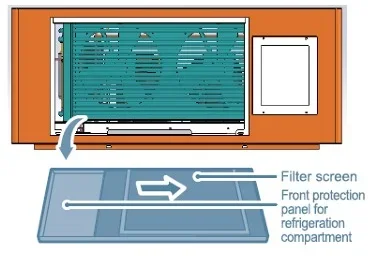NuAire Freezer
Cleaning Freezer Parts
Alert
- Clean the unit once a month.
- Use a dry cloth to wipe away loose dust inside and outside of the freezer. If the unit is dirty, use a clean cloth soaked with a neutral detergent solution. Using a dry cloth to wipe away any residual detergent solution.
- Do not pour water directly onto the exterior or into the interior of the unit. Water can damage the electrical insulation thereby causing a malfunction.
- Compressors and other mechanical parts are hermetically sealed. They do not need lubrication.
- Clean frost and ice off the unit once a month. Also, clean the condenser filter once a month.
When the cooler panel shows an alarm signal for “Hot Condenser”, the alarm light flashes. The filter still be cleaned once a month. If the filter is clogged, it will affect the refrigeration efficiency and reduce the product’s lifespan.
To clean the filter, follow the procedure below:
- Remove the front grill cover.
- Pull out the filter screen.
- Use water to wash the filter screen.
- After the filter screen is dry, reinstall it back in its original position and close the cover.
- If the “Hot Condenser” light is on before cleaning, check the light to make sure that it shuts off after cleaning. If it does not shut off, please contact service personnel.

Frost and ice can form between the door gasket and frame to form an air gap, which can decrease the refrigeration effect of the unit. Use the provided plastic scraper to remove excess frost.
To defrost the unit, follow the procedure below:
- Turn off any backup refrigeration system if applicable.
- Remove the samples from the unit that need to be defrosted. Move them to another unit or a container for temporary storage.
- Turn off the power supply.
- Open the outer door and inner doors to let the unit thaw.
- Use a dry cloth to soak up any water on the floor of the unit before restarting the unit.
- Load the samples back into the unit after it reaches the set temperature.
- Turn on the backup refrigeration system if present.
Caution: Do not use any sharp tools, such as knives or screwdrivers to defrost.
Recyclable and Rechargeable Battery
- If the battery capacity is low, please make sure the battery switch is turned on, and the battery will be charged. After about one week of charging, please recheck the battery capacity. If normal, the battery should be in full capacity; if the capacity is still low, replace the battery.
- The battery that supports the power outage alarm is a consumable item. The life expectancy for the battery is 2 to 3 years. If the battery is more than 3 years old, the battery should be replaced. To do so, please contact an Equipment and Instrument Service Center.
- Please keep out of children’s reach.
Disposal of the freezer should be carried out by professionals according to appropriate regulatory laws. The doors should be removed to prevent a accidents, such as asphyxiation from accruing.
The freezer is equipped with a recyclable rechargeable battery. When the battery reaches end of life, contact a local recycling organization to dispose of the battery.